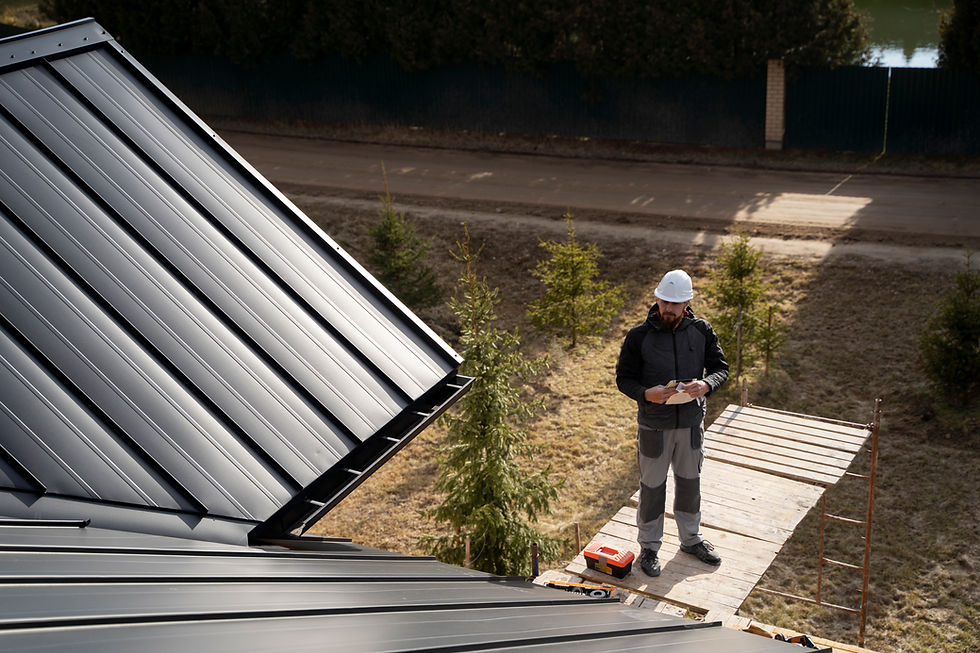The Right Way to DIY Your Roof
- John Shaw
- Mar 10
- 3 min read
Taking on a DIY roofing project can be a rewarding yet challenging task. Whether you're looking to make minor repairs or install a completely new roof, it's essential to follow the correct steps to ensure safety, durability, and effectiveness. While hiring a professional roofing service is always advisable for major projects, small-scale repairs or maintenance tasks can often be managed with the right approach. This guide will walk you through the proper way to handle DIY roofing, focusing on flat roofing and rubber roofing, two of the most common roofing types for homeowners.
Understanding the Basics of DIY Roofing
Before you begin your DIY roofing project, it's crucial to assess your skills, gather the right tools, and ensure that you fully understand the structure of your roof.
Safety First
Roofing can be dangerous, so prioritising safety is essential. Follow these precautions:
Use a sturdy ladder with rubber feet to prevent slipping.
Wear non-slip footwear designed for working on rooftops.
Avoid working in wet or windy conditions.
Always have a partner on the ground to assist if necessary.
Use a harness and safety rope when working on steep or high roofs.
Choosing the Right Materials
Different roofing materials require different techniques. If you're working with flat roofing, the two most popular materials are felt roofing and rubber roofing (EPDM). Both are known for their durability and water resistance.
Felt Roofing
Felt roofing is commonly used for sheds, garages, and outbuildings. It consists of layers of bitumen-coated felt, making it waterproof and durable. If you're looking to repair or install felt roofing, follow these steps:
Remove Old Felt – Carefully strip off the existing felt using a scraper.
Check for Damage – Inspect the roof for cracks or rot in the structure.
Apply a Base Layer – Roll out a new layer of felt, securing it with nails or adhesive.
Seal the Edges – Overlap seams and use roofing tar or a heat gun to create a watertight seal.
Add a Final Layer – Install the top layer for extra protection against the elements.
Rubber Roofing (EPDM)
Rubber roofing, also known as EPDM roofing, is highly durable and perfect for flat roofs. It is resistant to UV rays, weathering, and leaks. Here’s how to install rubber roofing correctly:
Clean the Roof Surface – Remove any debris and ensure the roof is dry.
Measure and Cut – Unroll the EPDM sheet and trim it to fit your roof dimensions.
Apply Adhesive – Use a roller to spread adhesive evenly across the surface.
Lay the Rubber Sheet – Carefully position the EPDM sheet and smooth out any wrinkles.
Seal the Edges – Use a strong sealant or flashing tape to secure seams and corners.
Check for Air Pockets – Use a roller to press down the rubber sheet and eliminate trapped air.

Common DIY Roofing Mistakes to Avoid
Many DIYers make avoidable errors when handling roofing tasks. Here are some common mistakes and how to prevent them:
1. Poor Weather Planning
Roofing should never be done in rainy or extremely hot conditions. Wet surfaces make work dangerous, while excessive heat can affect adhesive performance. Choose a dry, mild day for your project.
2. Incorrect Material Usage
Using the wrong materials can lead to leaks and early deterioration. For flat roofing, always opt for high-quality rubber roofing or felt roofing to ensure longevity.
3. Insufficient Sealing
One of the main causes of roof leaks is poor sealing. Make sure that all edges, seams, and flashing are securely sealed using appropriate waterproof adhesives and tapes.
4. Overlooking Drainage
Flat roofs require proper drainage to prevent water pooling, which can lead to leaks and damage. Installing a slight slope or adding drainage outlets will help water run off efficiently.
When to Call a Professional Roofing Service
While DIY roofing can be cost-effective, certain situations require expert intervention. If you experience any of the following issues, it’s best to consult a professional roofing service:
Severe water damage or rot in the roofing structure.
Sagging roof sections that indicate serious structural problems.
Large-scale roofing projects requiring extensive installation.
Uncertainty about safety measures or techniques.
A professional roofing service will ensure that the job is completed to the highest standard, providing you with peace of mind and a long-lasting result.
Final Thoughts
DIY roofing can be a rewarding experience, but it’s essential to approach it with the right knowledge, materials, and safety measures. Whether you're repairing flat roofing or installing rubber roofing, following these steps will help you achieve a durable and professional-looking finish. However, if you’re ever in doubt, don’t hesitate to seek assistance from a qualified roofing service to ensure the best outcome for your home. Happy roofing!



Comments